
Kusum, the Nachni and her Jhumur
In the Bake cylinder catalogue, Kusum is described as a Bhumij woman from Bankura, who sings a ‘jumur’. Arnold Bake had recorded her in Kenduli on 16 January 1932 (Bake India II, wax cylinder 108). Bake was picking up sights and sounds from the mela. In his letter home after Kenduli he wrote about what he saw there, the kinds of people who had gathered, the entertainers and performers and the devotees. ‘Freaks and outsiders’, bathers in the Ajoy, singers and fakirs, gatherings of sadhus beneath the banyan tree. He recorded all of this with his film camera—bathing scenes, the temple, little shops, baul dancer Ganesh Shyam, Kusum, the Bhumij woman’s dance and her drummer partner. The pair must have attracted Arnold Bake enough, which is why he did not only stop at filming them (the film can be seen here), but also asked Kusum to sing to his phonograph, accompanied by the drummer. Now, it is not as though these details were all given in Bake’s notes, the audio recording had the name of Kusum, the bhumij woman, the film did not have a description with a name. But looking and listening, alone and with others (especially discussing with Amy Catlin Jairazbhoy in 2010 and then she in turn asked Carol Babiracki), it was possible for us to match the film to the audio recording. In 2011, when we first launched the Travelling Archive website, we uploaded the Bake Bengal films with permission from the Archives and research Centre for Ethnomusicology in Gurgaon. If you go to the Bake page on TTA’a Related Research section now, you will see how little we knew at the time. Ten years on, there is absolutely no doubt about the identity of the dancers and the singers or that Kusum was a nachni.
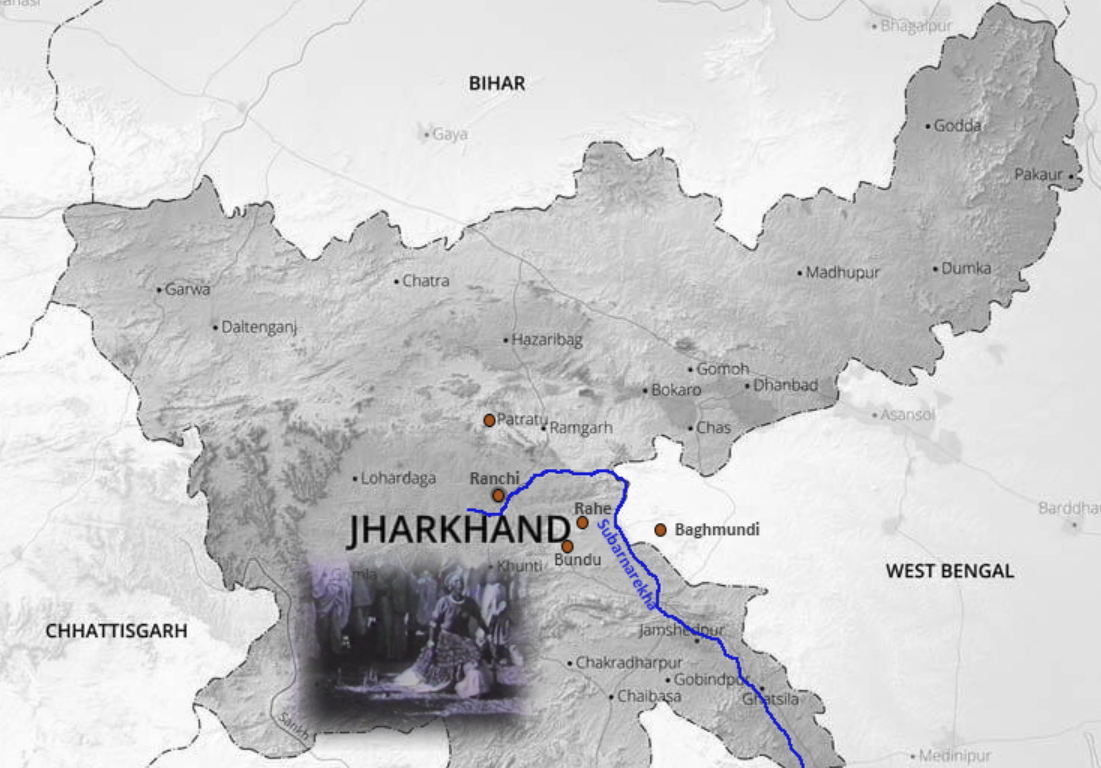
Map of all the places Kusum could have come from. Map by Purba Rudra
Who could Kusum have been? How come she was in Kenduli? Was she from Bankura or was that her temporary home at the time when Arnold Bake saw her in Kenduli? The man dancing with her, her rasik, who was he? Amy had sent me in 2010 a copy of a note her husband, ethnomusicologist and student of Arnold Bake, Nazir Ali Jairazbhoy and she had prepared on the Bengal videos of Bake for their own Bake Restudy. This note was based on Bake’s own notes.
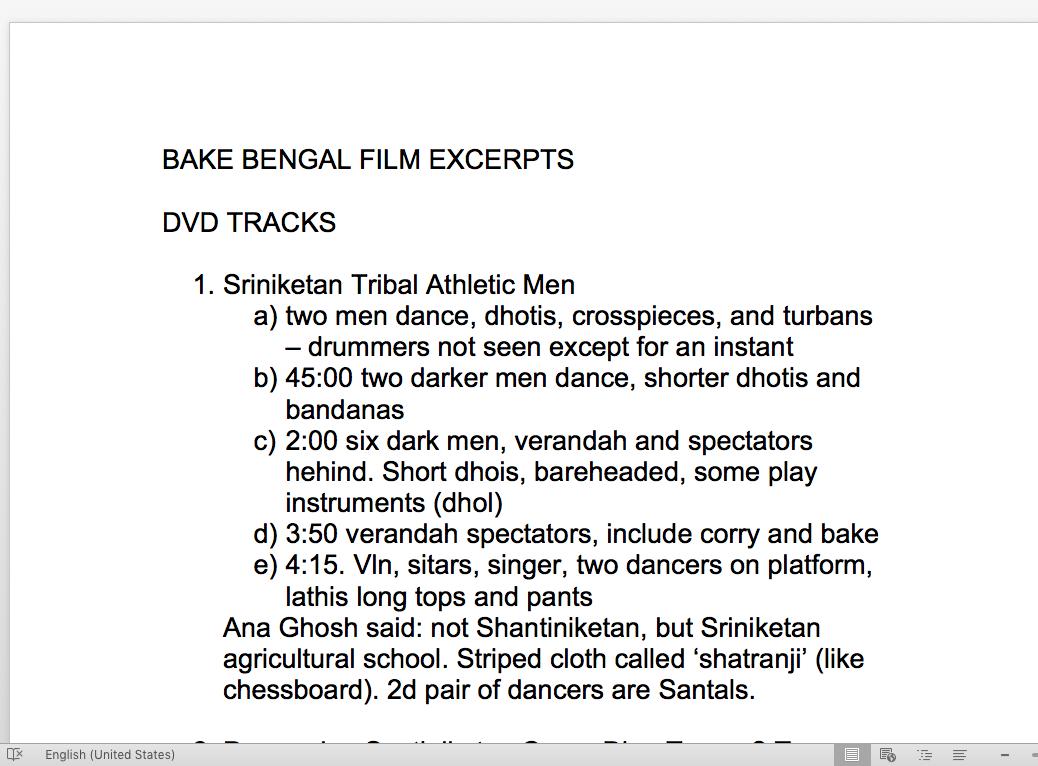
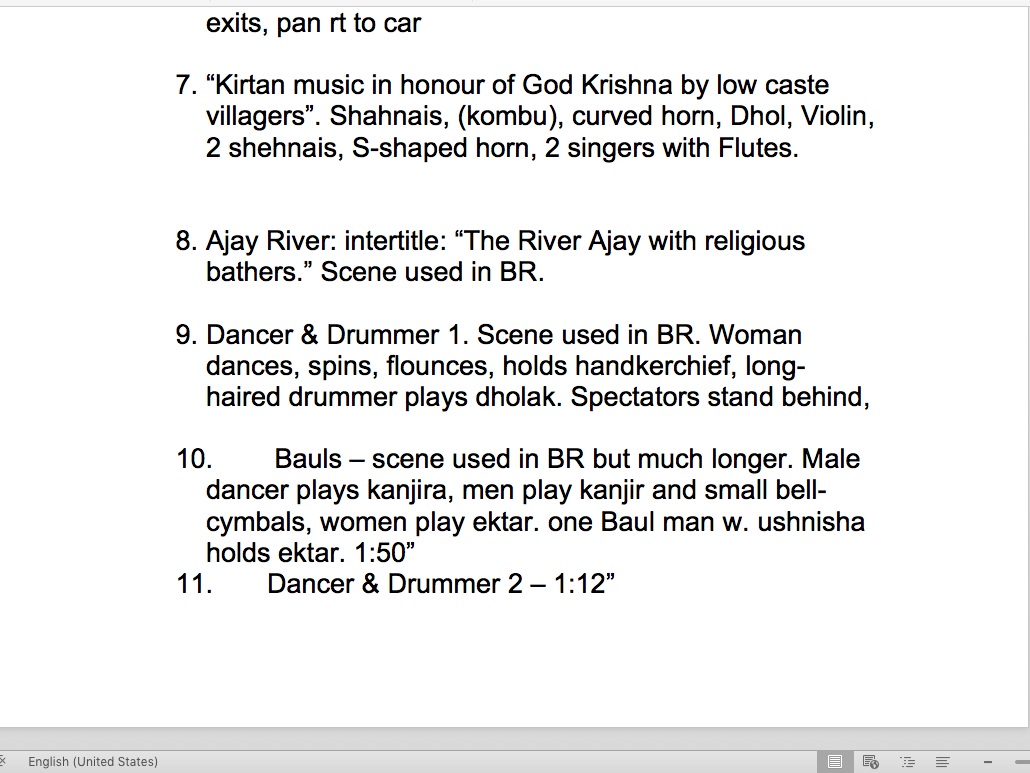
Notes from Amy Catlin Jairazbhoy, 2010
A nachni might have had many homes in many places, leading ‘an exceptionally nomadic life’, as Carol Babiracki wrote in her essay on Sundari Devi. ‘Like courtesans the world over, nacnis make an art of frustrating efforts to “know” them. Their desire to conceal in order to mitigate their triple social stigma (women, born “low-caste,” now “out-caste”) is certainly understandable, but these women actually seem to artfully cultivate the discourse of mystery that constitutes their performance culture in Jharkhand.’ (Carol M Babiracki, ‘Between Life History and Performance: Sundari Devi and the Art of Allusion’ in Ethnomusicology 52, no. 1 (2008): pp. 1-30. Accessed June 26, 2021.)
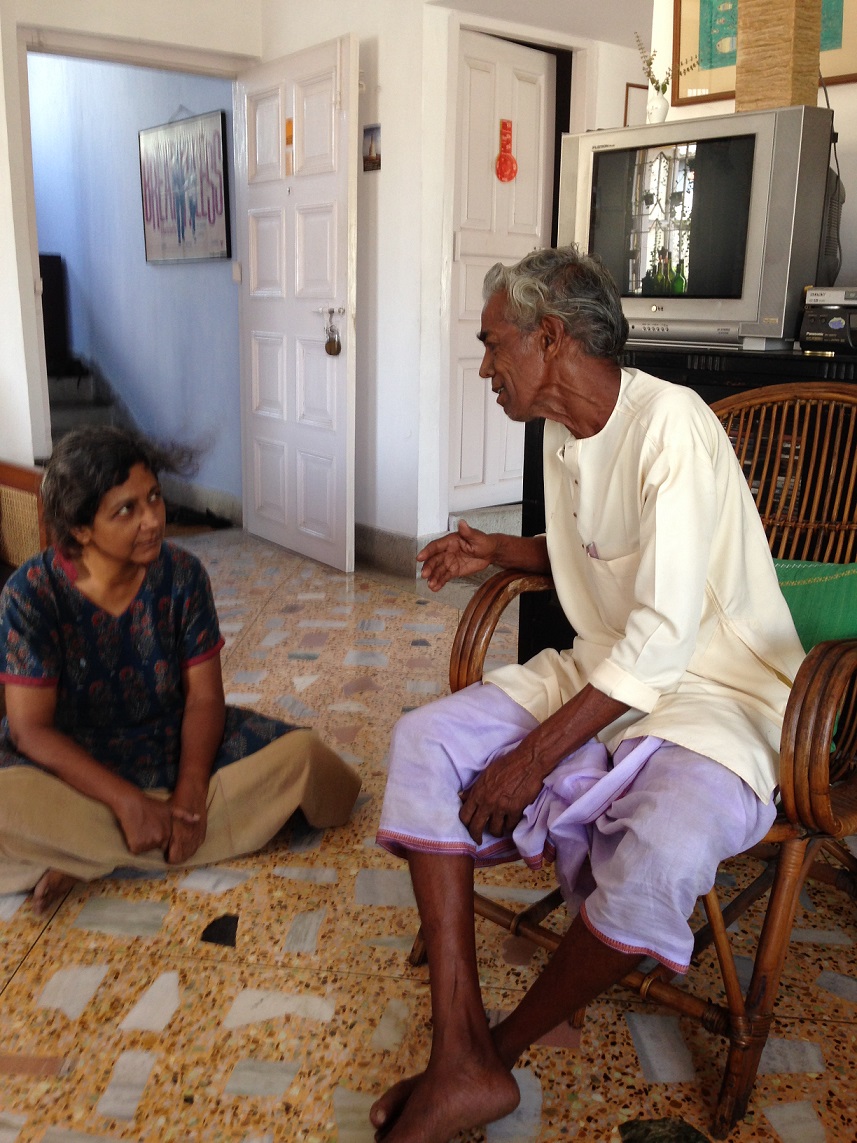
Senior jhumur artiste from Joypur, Purulia, Amulya Kumar, in my home, 2019. Photo: Abhijit Mazumdar
I had shared the song and film of Kusum with Amulya Kumar to know what he made of the recordings. I have known Amulya Kaka (as we call him) since 2005, there have been countless meetings and recording sessions. Kaka had come to my home on 5 December 2016. We had the following conversation; it is hard to summarise the content, because it so comes out of Kaka’s place and his life—he was born around 1938 and has seen and learned much. He had to just listen to the song and began to tell me the names of places from where such songs come: Bundu, Bagmundi, Rahe, Patratu, Ranchi. Then when he saw the video, he nodded in approval and said, ah! That’s what I was saying. She will have a handkerchief and not cover her head, sometimes there will be tassels hanging from both sides.
Amulya Kumar responds to Kusum’s song and dance, December 2016.
This is a ‘Tamariya’ melody, from Bagmundi. You know how the language of Purulia is different from Kolkata? Like that in these places they speak and sing in a different way—Rahe, Bundu, Patratu. He says ‘Patrahatu’. I ask him about what people there do for a living; work in the fields and forests he says, or do business. I ask about the life of the nachni, her relationship with her partner (rasik), about her song, about how she becomes a nachni. Kaka knows so much and his language is so beautiful, full of words which have a topographical dimension to them, signifying place. He hums and sings a few lines as he talks. ‘Ashadh maasher dine/Torope chhatiya’. You hear the Manbhum region in his those words and the way he utters them. Bengal is leaving Bengal and becoming Bihar—the song holds that middle place. Kaka says, it is the song which pulls the nachni out of her home. The song of the rasik. She goes with him. Lives a marginal life, is never given equal place with the wife. Always ostracised. It is a life of pain and suffering, but love too. He tells me a story about how, many years ago, 50 or 52 perhaps, when his eldest daughter had just been born, there was a girl who heard him sing and wanted to come with him. He was on an election campaign with the local candidate. He had to sing and draw crowds. The girl climbed on the jeep and said she would go wherever he went. ‘Oh my god! The sky came down on me!’ the 78-year-old man said and laughed his typical laugh. ‘My mother used to say, don’t sing when you are working in the field.’
Beautiful stories. There is an intimacy between Kaka and me—over the years, he has become a kind of parent. So, I can lovingly order him around: now you sit here, now you sing. He smokes his bidi and tells me most of the words of Kusum’s song and says we have such songs too, but we don’t sing them this way. These are biraho songs, songs of separation and longing. How does your song go? He sings a bit and stops. I don’t sing such songs. Why? Because it hurts, is it? Yes. You remember things. Your own things.
Then, there was my conversation with Bishu.
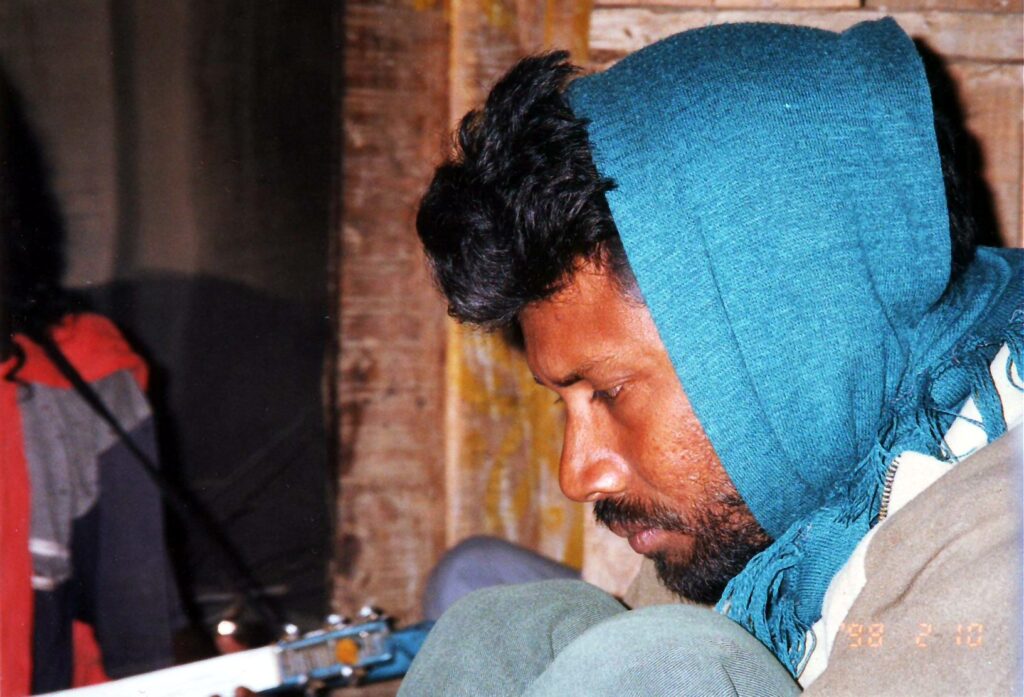
Bishu in Joypur, Bhaddi, Purulia. 2005. Photo: Sudheer Palsane
Telephonic conversation with Biswanath Dasgupta (Bishu) , 18 and 27 January 2021.
Bishu grew up in Joypur Purulia. His father was a doctor. They are not local in the same way as Kaka is, they are outsiders, arrived in this place for professional reasons, the educated middle-class. But Bishu is local in his own way. He grew to love the language and culture of Purulia, he never thought of leaving. I guess he was in his late twenties when we met, will be 42-43 now. He has deep knowledge of the folk arts of the entire Purulia, Bankura, Jharkhand regions, places of Jhumur and Chhau (the masked dance). He has worked as a theatre activist and organised folk festivals for decades. He has been a kind of conduit between the metropolis and his region. Bishu had taken us to Amulya Kaka in 2005. For about a decade we had not been in touch. Then we connected again.
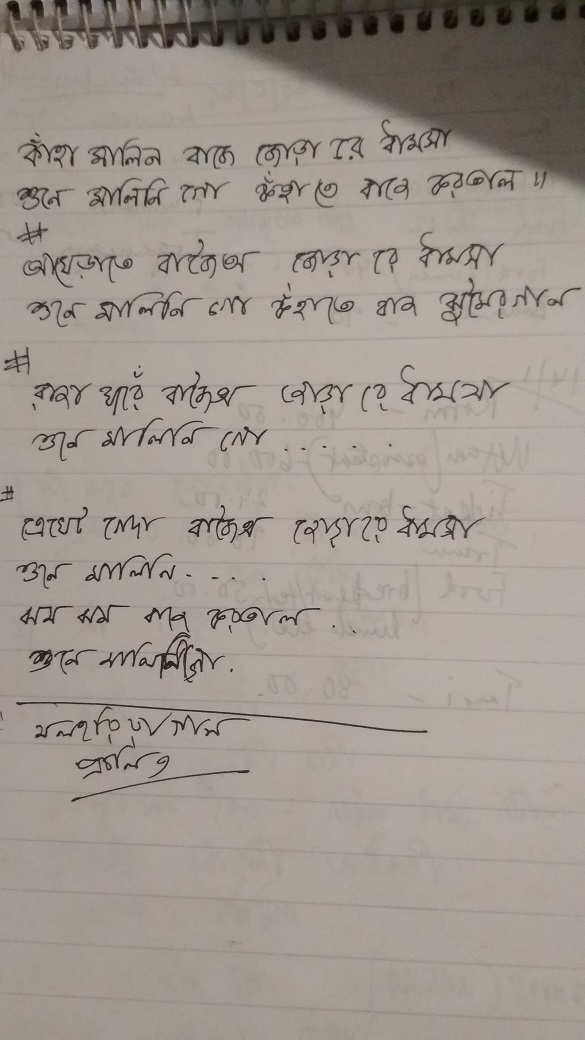
Bishu wrote this song in my notebook in Joypur, Bhaddi, Purulia in 2005.
Before I sent the file to Bishu we were talking about nachnis and why the women leave home. Bishu expresses himself in a way different from Amulya Kaka, he talked about sringar rasa—the essence of erotic love. He said they are often widows. The cry of the bhaduria jhumur pulls them out of their homes. He talked about Sindhubala, the renowned nachni who tried to bring recognition to their community and her artform. ‘She was 92 at the time and she said, you see Raja—she used to call me Raja [Bishu stresses on the ‘j’ and rolls the r, rrajjaa, he says]—she said, I am so immersed in this rasa that my life is slowly shrinking away. Rawshe thaikte thaikte shukhai gelam. And I said, how so? How can you be drowning in rasa and yet go dry? Even at ninety you are drinking, singing, and you say you are going dry? And she said, that is how it is. That is how it happens. It is this rasa which sucks the juices out of you.’ Then Bishu also talked about Kamala Jharia, the famous kirtan singer who had started life as a nachni.
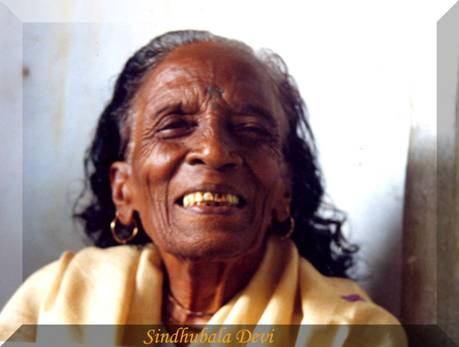
Sindhubala Debi. Source: Internet.
When we talked again, Bishu had listened to the song and seen the film. He said, it is a treat to be able to see this. She is singing in Kurmali and dancing an ‘ekoira’ dance, meaning doing a solo performance. He talked about the evolution of nachni dance, those who sang and danced for the royal court, whose who performed for the ordinary people, then how the protocols of stage performance evolved. We also talked about the last time we met, the song he had taught me and I sang some lines.
Bishu sang ‘Kahan malin baje’ in 2005 in Amulya Kaka’s house, which I had learned from him. Recorded by Sukanta Majumdar.
- Laksmisvar Sinha, a Doorway to Many Worlds
- Imam Bux Boyati of Mymensingh at Gurusaday Dutt’s Suri Mela
- Motru Sen and Jaya Tagore: From Image to Sound
- Mapara’s Cradle Song and Shruthi Vishwanath’s Response
- The Bauls of Kenduli in 1932
- Pinakin Trivedi and the Autograph Book
- Roof-Making Songs of Baori Women
- Listening to Savitiri Govind with Sumana Chandrasekhar
- From Ranjan Shaha to Kobiyal Akhtar Shah in Kasba, Birbhum
- From Gurudayal Malik to Mohan Singh Khangura and Madangopal Singh
